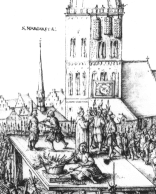 In the sixteenth century a number of increasingly vocal critics of the practices and beliefs of the Catholic church emerged. These criticisms, taken as a whole, became known as the Protestant Reformation, the effects of which were felt across Europe as new churches emerged. Switzerland, in particular, was a hotbed of religious reform being birthplace of Calvinism and the Anabaptist faith, although some historians maintain that the latter also had roots in Holland and the Rhineland.
In the sixteenth century a number of increasingly vocal critics of the practices and beliefs of the Catholic church emerged. These criticisms, taken as a whole, became known as the Protestant Reformation, the effects of which were felt across Europe as new churches emerged. Switzerland, in particular, was a hotbed of religious reform being birthplace of Calvinism and the Anabaptist faith, although some historians maintain that the latter also had roots in Holland and the Rhineland.
The Anabaptists were so called because they deferred baptism until somebody is old enough to chose to enter the faith. Not only did Anabaptists want religious reform but also formed a social reform movement, which became increasingly radicalised during the Peasants’ War, a series of popular revolts that flared up across the Holy Roman Empire in 1524 and 1525. The princes and bishops restored order, re-established the status quo, and in some places, they made conditions even harsher for the common people, many of whom were radicalised and so became Anabaptists.
One place where the seeds of radical religious and social reform took root was the German of Münster. Ruled by a bishop, Franz von Waldeck, and council of guild leaders, the citizens looked to religious leaders to bring about social change. The Anabaptist pastor Bernhard Rothmann declared that a new prophet would soon arrive to liberate the people of the city. This ‘prophet’ was a Dutch baker called Jan Matthys, who along with Rothmann and Jan Bockelson, a tailor from Leyden, whipped up such religious sentiment within the populace that in February 1534 they managed to drive the council and bishop from the city and install their own mayor, Bernhard Knipperdolling, a guild leader and Anabaptist convert.
In Easter of that year, Matthys set out to conquer the rest of the world believing that the Day of Judgement was at hand, but he and his thirty followers died at the hands of the bishop’s besieging army. Bockleson took over as religious and political leader and instituted a number of social reforms including the legalisation of polygamy and instituting the community of goods. He claimed to be a descendent of King David and as such was the absolute ruler of the new ‘Zion’.
Nevertheless, this new ‘Zion’ was not to last. On the night of 24th June 1535, the bishop’s forces finally gained entry to the city using information gained from Heinrich Gresbeck, who had been a guard on the city walls and was captured while trying to flee. The bishops forces quickly took the city, capturing the Anabaptist leaders and killing almost all of the male population. Bockelson and Knipperdolling were tortured and eventually executed in January 1536, their mutilated bodies were displayed in cages hung from the steeple of St. Lambert’s Church, which are still there today.
The Global Anabaptist Mennonite Encyclopaedia Online has a more detailed account of the Münster Anabaptists.


